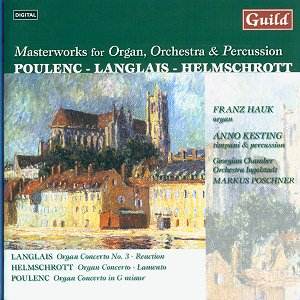Besides a considerable amount of organ and choral music,
Langlais composed three organ concertos (1949, 1961 and 1970/1 respectively)
which have never been recorded so far. His Réaction – Organ
Concerto No.3 was completed in 1971 and first performed in 1976
in Pittsburgh. The subtitle is rather puzzling or misleading, for there
is nothing reactionary in this substantial work cast in a clear 20th
Century idiom, even though Langlais’s organ writing may be somewhat
less adventurous than Messiaen’s. The opening drum-roll followed by
a nervous gesture in the strings sets the scene: this will be a serious
often dark-hued, intense piece of music with very little relief, if
indeed any at all. The structure, in five interlinked sections, is unusual:
a long weighty introduction stating the concerto’s basic thematic material
leads into a short, nervous Scherzo fading into the real core of the
entire work: a powerful fugue sometimes recalling Honegger’s muscular
and virile writing. This is followed by a cadenza leading into the final
short coda. Neither reactionary nor revolutionary, Langlais’s Third
Organ Concerto is an intensely serious and powerful work of substance.
Helmschrott too has composed (and, presumably, still
does so) a huge amount of organ music, in which his large-scale cycle
of twelve Church Sonatas (the First Sonata for trombone and organ was
written in 1984 as a commission by the Department of Culture of Ingolstadt)
has the lion’s share. Some of his orchestral and vocal music is also
available on Vienna Modern Masters (Entelechiae for soprano
and orchestra of 1977 on VMM 3035 and his oratorio Kreuz und Freiheit
on VMM 3027). His Lamento – Concerto for Organ, Strings and Percussion,
another Ingolstadt commission, was completed in 1993 when the composer
was artist-in-residence at the McDowell Colony. It is laid-out in two
weighty movements of broadly equal length framing a short Interludium.
All the main material is based on an eight-tone row stated at the outset
of the work. The first movement is mostly dramatic and declamatory in
mood. It generates considerable tension, briefly dispelled in the peacefully
musing Interludium. The second movement displays some forceful
energetic writing. A slower middle section eases the nervous tension
before the powerful reprise rushing the concerto to its emphatic conclusion.
A substantial work and a most welcome novelty whose deeply felt and
intense earnestness of purpose sometimes recalls Frank Martin in its
freely atonal but highly communicative idiom.
By comparison, Poulenc’s better-known Organ Concerto
in G minor (one of his supreme and most perfect masterpieces,
by the way) might seem lightweight, which it is not. Quite the contrary;
it is one of his most serious and most personal statements. It is miles
away from his customary, easy-going and light-hearted playfulness, that
nevertheless often conceals some deeply rooted sadness. However l’ironie
est la politesse du désespoir, a saying that often applies
to Poulenc’s bitter-sweet music. Poulenc, however, was also a deeply
religious man who expressed his faith in short choral works as well
as in his large-scale trilogy of choral-orchestral works culminating
in his last masterpiece Sept Répons des Ténèbres.
Though not overtly religious, the Organ Concerto belongs to his most
personal music making, even if it has that playful sixth section inspired
by the sight of serious monks playing football! Poulenc, who was not
trained as an organist, admitted that his model was Buxtehude, though
the final product is pure Poulenc. Maurice Duruflé, who gave
the first performances of the Organ Concerto, also acted as technical
adviser during the composition of the piece.
Guild’s hopefully ongoing series is going from strength
to strength, thanks to Franz Hauk’s dedicated advocacy and persuasion.
Of Guild’s enthusiastic support. I now hope that forthcoming releases
in this series will include any (or all!) of the following: Rainer Kunad’s
Organ Concerto (with double string orchestra and timpani) as well as
those of Hamilton, Hoddinott and Mathias, and – why not? – Langlais’s
First and Second Organ Concertos.
Production is excellent and up to Guild’s best standards.
The recording team again cope quite successfully with Ingolstadt Liebfrauenmünster’s
reverberant acoustics. Another warm recommendation.
Hubert Culot


